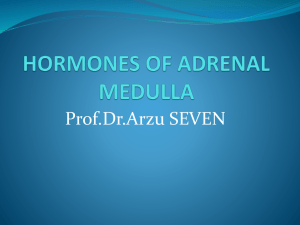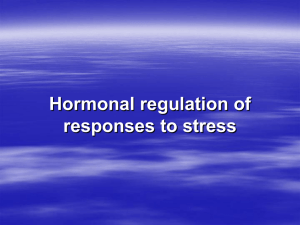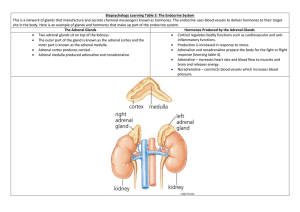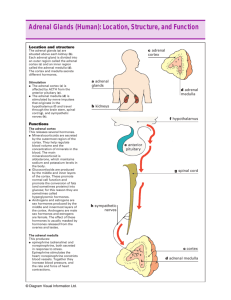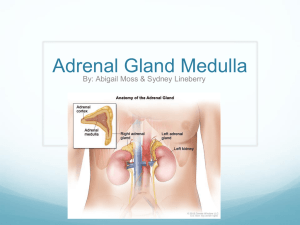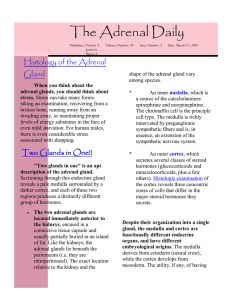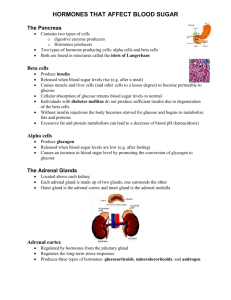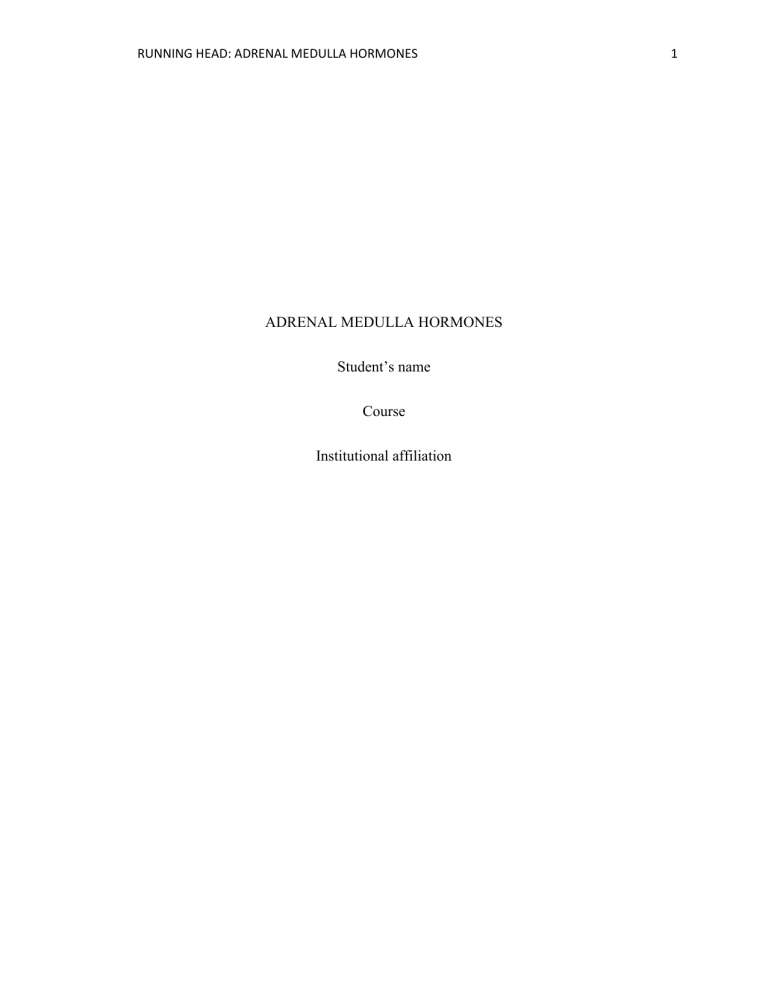
RUNNING HEAD: ADRENAL MEDULLA HORMONES ADRENAL MEDULLA HORMONES Student’s name Course Institutional affiliation 1 ADRENAL MEDULLA HORMONES 2 Introduction The current paper is an academic essay on the adrenal medulla as to meet the objections of understanding the functions and dysfunctions of this organ. Outlined in this essay will be the various regulatory mechanisms that underpin secretion and the mechanism of action of these hormones on the target tissues. Regulation of secretion The medulla produces primarily the catecholamines epinephrine, norepinephrine and dopamine (Wong, 2006). Epinephrine is the main catecholamine produced by the adrenal medulla. These are hormones with varied systemic effects but basically control the “fight or flight” response in physiological, psychological and environmental stress (Waugh & Grant, 2010). Control of secretion is through neural mechanisms (De Diego, Gandia, & Garcia, 2008). The adrenal medulla acts as an amplifier to the sympathetic nervous system and is actually modified neural tissue composed of neuroendocrine cells hence under similar neural control as the sympathetic nervous system (De Diego, Gandia, & Garcia, 2008). To illustrate this regulation the following diagram is used: ADRENAL MEDULLA HORMONES 3 During physiologic, physical or environmental stress for example exercise, fasting, cold or heat, inflammation, pain, anxiety, hypovolemia, hypoglycemia or emotional stress, the body perceives a threat to normal homeostatic balance and initiates a response via the hypothalamus (Barrett, Barman, Boitano, & Brooks, 2009). The hypothalamus mediates this response depending on the type of stress. Immediate stress will activate the sympathetic nervous system and the adrenal medulla to produce catecholamines while a prolonged stressor will cause the release of a corticotropin-releasing hormone that causes the release of ACTH from the anterior pituitary which in turn activates the adrenal cortex to produce adrenocorticoids (Waugh & Grant, 2010). A sympathetic nervous discharge will travel through the spinal cord and the sympathetic preganglionic neuron to synapse with chromaffin cells of the adrenal medulla. The chromaffin cells act as modified postganglionic neurons and respond to acetylcholine neurotransmitter from the preganglionic neuron to release mainly epinephrine via exocytosis (De Diego, Gandia, & Garcia, 2008). The epinephrine is released into circulation to effect the hormonal action on target organs. ADRENAL MEDULLA HORMONES 4 Mechanism of action at the target organ Epinephrine has various effects on target organs including increasing the heart rate, blood pressure, vessel constriction to divert blood from non-essential organs like skin to more essential organs like heart and brain, increasing the metabolic rate and pupillary dilatation just to name a few (Waugh & Grant, 2010). These responses are aimed at enhancing and facilitating recovery from a stressor. For it to exert its action on any organ, the cells must have cell surface receptors specific for it. Like most peptide and amine hormones, catecholamines have cell surface receptors. Catecholamines bind their specific receptors named adrenergic receptors (Badino, Odore, & Re, 2005). They are of two forms: alpha (α) and beta (β). They are further subdivided into α1, α2, β1, and β2 (Badino, Odore, & Re, 2005). Each of this receptor subtypes have effects on organs, either inhibitory or excitatory. The receptors are coupled to membrane proteins that activate an intracellular cascade leading to release of second messengers that effect cellular action. Beta receptors are coupled to a G protein that activates adenylyl cyclase on hormone-receptor coupling (Johnson, 2006). This increases the levels of the second messenger cyclic AMP which will activate protein kinase A. α1 receptors are coupled to phosphatidylinositol and uses calcium as the second messenger leading to activation of protein kinase C. α2 are coupled to inhibitory G protein that will decrease levels of cyclic AMP (Hein, 2006). The effects of epinephrine on these target organs depends on the subtype of receptors that the organ expresses. α1 receptors are mostly expressed on smooth muscles and mediate smooth muscle contraction including vasoconstriction (Hein, 2006). α2 receptors are expressed on ADRENAL MEDULLA HORMONES 5 presynaptic adrenergic nerve terminals and on lipocytes, platelets and some on the smooth muscle. β1 receptors, on the other hand, are expressed on the heart, lipocytes, kidney, ciliary body and adrenergic nerve terminals (Tanaka, Horinouchi, & Koike, 2005). Β2 receptors are postsynaptic on effector cells especially cardiac and smooth muscle (Tanaka, Horinouchi, & Koike, 2005). Conclusion The adrenal medulla produces epinephrine, norepinephrine, and dopamine. This secretion is mediated by neural control as the chromaffin cell acts as a sympathetic postganglionic neuron and is under the influence of the sympathetic nervous system. The mechanism of action that mediates its action on target organs involves the interaction of the hormone with specific adrenergic cell surface receptors that activate an intracellular cascade and produces its effect through second messengers cyclic AMP and calcium. ADRENAL MEDULLA HORMONES 6 References Badino, P., Odore, R., & Re, G. (2005). Are so many adrenergic receptor subtypes really present in domestic animal tissues? A pharmacological perspective. The Veterinary Journal, 170(2), 163-174. Barrett, K. E., Barman, S. M., Boitano, S., & Brooks, H. (2009). Ganong’s review of medical physiology. 23. NY: McGraw-Hill Medical. De Diego, A. M. G., Gandia, L., & Garcia, A. G. (2008). A physiological view of the central and peripheral mechanisms that regulate the release of catecholamines at the adrenal medulla. Acta physiologica, 192(2), 287-301. Hein, L. (2006). Adrenoceptors and signal transduction in neurons. Cell and tissue research, 326(2), 541-551. Johnson, M. (2006). Molecular mechanisms of β2-adrenergic receptor function, response, and regulation. Journal of Allergy and Clinical Immunology, 117(1), 18-24. Tanaka, Y., Horinouchi, T., & Koike, K. (2005). New insights into β‐adrenoceptors in smooth muscle: distribution of receptor subtypes and molecular mechanisms triggering muscle relaxation. Clinical and Experimental Pharmacology and Physiology, 32(7), 503-514. Waugh, A., & Grant, A. (2010). Ross & Wilson Anatomy and Physiology in Health and Illness E-Book. Elsevier Health Sciences. ADRENAL MEDULLA HORMONES Wong, D. L. (2006). Epinephrine biosynthesis: hormonal and neural control during stress. Cellular and molecular neurobiology, 26(4-6), 889-898. 7
